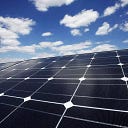Why Solar Wins…? Jobs
If you want to create American jobs, it’s hard to beat renewable energy.
In the United States, there are already many more people working in solar energy than in the coal industry — and while coal is on the downward slope of its life cycle, solar and other renewables are just getting started.
Coal, which fuels about 30 percent of U.S. electric generation (and that share is shrinking), employs about 75,000 Americans throughout its value chain.
So far, solar supplies just about 1 percent of electricity generation but is growing fast. Yet solar already employs more than 260,000 Americans, according to the Solar Foundation, and could well employ a million people within a decade.
The growth in clean energy is not just an American phenomenon. Worldwide last year, more than twice as much money was invested in building renewable electricity generation — mostly wind and solar — than was invested in generating fossil fuels like coal and gas.
When it comes to new power generation, renewables are now the standard, while fossil-fueled options are rapidly slipping to “alternative” status.
It’s hardly a shock that innovative technologies replace legacy ones as old industries die out and new ones rise to surpass them. It’s a pattern that has been repeated time and time again.
Telegraphs gave way to telephones 📞 landlines gave way to cellphones ☎️ ️📲 and now people carry smartphones 📱 that double as computers, cameras and music players 💻 📹 📻
Once people sailed between continents ⛵️then steamships took over 🚢 and now everybody flies 🚄 🛩 🚀
What we’re experiencing in the power sector is a similarly historic shift. Dirty, centralized, capital-intensive systems like coal-fired power plants rely on 19th century technology and an inefficient grid to transport electricity to homes and businesses across the country.
The 21st century’s clean systems — including on-site options like rooftop solar — incorporate buildings and transportation charging through a smart grid that is redefining our relationship with energy.
Transition can create real hardships. The number of coal miners has been dwindling for decades now, as big machines have replaced the work of thousands of people. Although these fossil energy companies’ profits soared for a while, they have now crashed.
For these Americans and others who have been left behind by this fast-changing economy, the hurt is real. But the answer is not bringing coal back, as Donald Trump seems to think. Creating new good jobs is fundamental if we are to sustain a vibrant middle class in America.
And that brings us to one of the blessings of renewable energy: It is labor intensive. Whether you calculate it in terms of jobs per unit of energy or jobs per dollar spent on electricity, broadly speaking, renewable energy is four to seven times more “job dense” than fossil-fueled energy. `
To put it another way, an energy need that 100 workers could meet in a fossil-fueled scenario needs 400 to 700 workers in a renewable energy scenario.
And the clean option can be just as profitable, because capital requirements are lower than big mines and such, transmission inefficiencies are reduced with distributed generation and the fuel — sunlight or wind — is free.
Clean energy is already proving its worth as a generator of quality jobs — especially for veterans.
It’s no secret that men and women who have served the United States in uniform can have a tough time finding civilian jobs once they’re home. But through programs like Solar Ready Vets, many veterans are building solar energy careers; in fact, a little over 8 percent of all Americans employed in the solar sector are veterans. Many say they see their work building a more energy-independent nation as one more way to serve and defend their country.
Clean energy jobs range from installation and maintenance to engineering, sales and finance. And we need people to develop the technologies that allow wide use of renewable energy on the electrical grid, from utility-scale battery storage to smart grid software that ties buildings together and manages energy supply and demand.
Like other parents across the globe, I believe we should strive to leave our children a world that’s better than we found it. Right now, because of climate change, we are failing our kids. Economically, the coming generation faces the prospect of fewer good jobs (not gig jobs) than the one before it for the first time since World War II.
Embracing clean, renewable energy is one realistic and technologically proven option we have for saving this planet from the worst effects of climate change and solving our economic challenges. It will give our kids a better future — while creating the good jobs that hard-working families deserve.
Danny Kennedy serves as managing director of the California Clean Energy Fund, which connects money to investments, ideas to support and issues to solutions. He co-founded the solar company Sungevity and serves on the board of VoteSolar.

